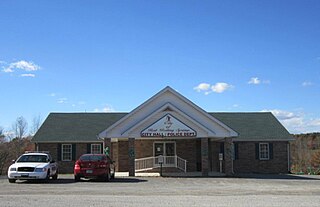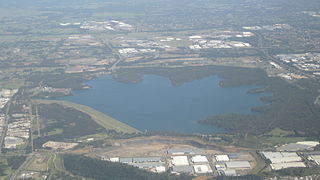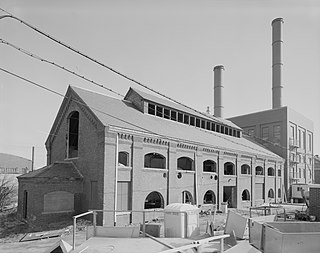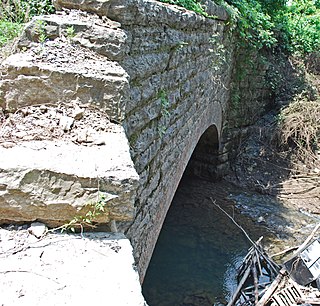
Red Boiling Springs is a city in Macon County, Tennessee, United States. The population was 1,112 at the 2010 census.

The Jerome Park Reservoir is a reservoir located in Jerome Park, a neighborhood in the North Bronx, New York City. The reservoir is surrounded by DeWitt Clinton High School, the Bronx High School of Science, Lehman College, and Walton High School.

The B Reactor at the Hanford Site, near Richland, Washington, was the first large-scale nuclear reactor ever built. The project was a key part of the Manhattan Project, the United States nuclear weapons development program during World War II. Its purpose was to convert natural uranium metal into plutonium-239 by neutron activation, as plutonium is simpler to chemically separate from spent fuel assemblies, for use in nuclear weapons, than is to isotopically enrich uranium into weapon-grade material. The B reactor was fueled with metallic natural uranium, graphite moderated, and water-cooled. It has been designated a U.S. National Historic Landmark since August 19, 2008 and in July 2011 the National Park Service recommended that the B Reactor be included in the Manhattan Project National Historical Park commemorating the Manhattan Project. Visitors can take a tour of the reactor by advance reservation.

The City of Toronto Water Division is a municipal division of the City of Toronto under Infrastructure and Development Services that is responsible for the water supply network, and stormwater and wastewater management in Toronto, Ontario, Canada, as well as parts of Peel and York Regions.

The New Milford Plant of the Hackensack Water Company was a water treatment and pumping plant located on Van Buskirk Island, an artificially created island in the Hackensack River, in Oradell, Bergen County, New Jersey, United States. The site was purchased in 1881 by the Hackensack Water Company, which developed it for water supply use. The facility was built between 1881 and 1911, and it includes a brick pumping station from 1882, a tall filtration tower, and huge underground infrastructure. The Hackensack Water Company was merged into United Water in the 1980s; the successor today is Suez North America.

The Prospect Reservoir is a heritage-listed 50,200-megalitre potable water supply and storage reservoir created by the Prospect Dam, across the Prospect Creek located in the Western Sydney suburb of Prospect, in New South Wales, Australia. The eastern bounds of the reservoir are a recreational area and the western periphery are within the bounds of Western Sydney Parklands. It was added to the New South Wales State Heritage Register on 18 November 1999.

The Halifax Regional Water Commission (HRWC), publicly known as Halifax Water, is the municipal water, wastewater and stormwater utility serving the residents of the Halifax Regional Municipality (HRM), pursuant to the Public Utilities Act. An autonomous, self-financed utility, Halifax Water is a fully metered water utility providing water, fire protection, wastewater and stormwater services as regulated by the Nova Scotia Utility and Review Board.

The Washington Park Sewage Pumping Station is an historic wastewater pumping facility in Providence, Rhode Island. Its principal visible component is a concrete block structure, finished in stucco and topped by a hip roof, which is about 16 by 16 feet. This building stands atop a large cast-in-place concrete well, in which pumps and gate valves are housed. The facility was built in 1911 to pump raw sewage from the low-lying Washington Park area to the Field's Point wastewater treatment facility, which lies about 1,000 feet (300 m) to the north. The pump station is located well back from the street, behind a low brick distribution facility. It was added to the National Register of Historic Places in 1989.

Fall River Waterworks is a 22-acre (8.9 ha) historic site located at the eastern end Bedford Street in Fall River, Massachusetts, along the shore of North Watuppa Pond. The property, which is still used as a water works for the city, contains the original pumping station, intake house and 121-foot (37 m) tall standpipe water tower. The system was originally built between 1872 and 1875, and expanded or upgraded many times. It was added to the National Register of Historic Places in 1981.

The May 2010 Tennessee floods were 1,000-year floods in Middle Tennessee, West Tennessee, south-central and western Kentucky and northern Mississippi areas of the United States of America as the result of torrential rains on May 1 and 2, 2010. Floods from these rains affected the area for several days afterwards, resulting in a number of deaths and widespread property damage.

The Chillicothe Water and Power Company Pumping Station is a historic building on the northern side of Chillicothe, Ohio, United States. A Gothic Revival structure built in 1881, it was constructed to house the city's waterworks and power plant. Its architecture and its location in Yoctangee Park was chosen specifically in order to beautify the park as well as to have a location near other elements of the city's first waterworks, which were built at the same time as the pumping station.

The Davenport Water Co. Pumping Station No. 2, also known as the Ripley Street Pumping Station No. 2, is located in central Davenport, Iowa, United States. It has been listed on the National Register of Historic Places since 1984. The historic building has subsequently been replaced in 1986 by a smaller plain structure on the same property facing West 14th Street.

The Office of City Engineer of Providence, Rhode Island is an office that is credited with the design of a number of notable public works.

Bleachery Water Treatment Plant is a historic water treatment plant located at Rock Hill, South Carolina. It was built in 1930, and is a one-story brick building and filtration/purification facility in the Colonial Revival style. The city of Rock Hill passed a bond issue to build Bleachery Water Treatment Plant, to support the Rock Hill Printing and Finishing Company investment by M. Lowenstein Company of New York.

The Morgan – Whyalla pipeline was an engineering project undertaken by the South Australian Government in 1940 to bring water from Morgan on the River Murray to the industrial city of Whyalla. A second pipeline, by a divergent route, was laid in the 1960s.

Richland Creek is a stream in the western part of Nashville, Tennessee, in Davidson County. It winds for 28 miles (45 km) through the Nashville suburbs of Belle Meade and Forest Hills and eventually flows into the Cumberland River near Rock Harbor Marina at the end of Robertson Avenue. This is one of at least five streams by the name of "Richland Creek" in various regions of Tennessee.

The Glendive City Water Filtration Plant, in Glendive, Montana, was built in 1917 after years of delays, after the city was founded in 1902. Water was delivered in barrels to residences in Glendive until it was completed. It was listed on the National Register of Historic Places in 1988.

The Lebanon Road Stone Arch Bridge is a historic bridge over Brown's Creek in Nashville, Tennessee, U.S.. It was designed by J. A. Jowett, and its construction was completed by the Foster and Creighton Company in 1888. From its construction to 1925, it was used by drivers on Lebanon Road. There is also a water main on the bridge to carry water from a water plant to the Eighth Avenue South Reservoir. It has been listed on the National Register of Historic Places since May 13, 1987.

The Monroe Avenue Water Filtration Plant is a municipal water treatment plant located at 430 Monroe Avenue NW in Grand Rapids, Michigan. Built in 1910, it was likely the first water filtration plant in Michigan. In 1945, the plant was the site of the first public introduction of water fluoridation in the United States. It was listed on the National Register of Historic Places in 2002. The building now serves as an event center, known as Clearwater Place.

Tate Springs was a historic world-class luxury resort complex located on U.S. Route 11W in Bean Station, Tennessee, United States. Known for its mineral spring water shipped internationally, it was considered to be one of the most popular resorts of its time in the Southern United States, and was visited by many wealthy and prominent families such as the Ford, Rockefeller, Firestone, Studebaker, and Mellon families.






















